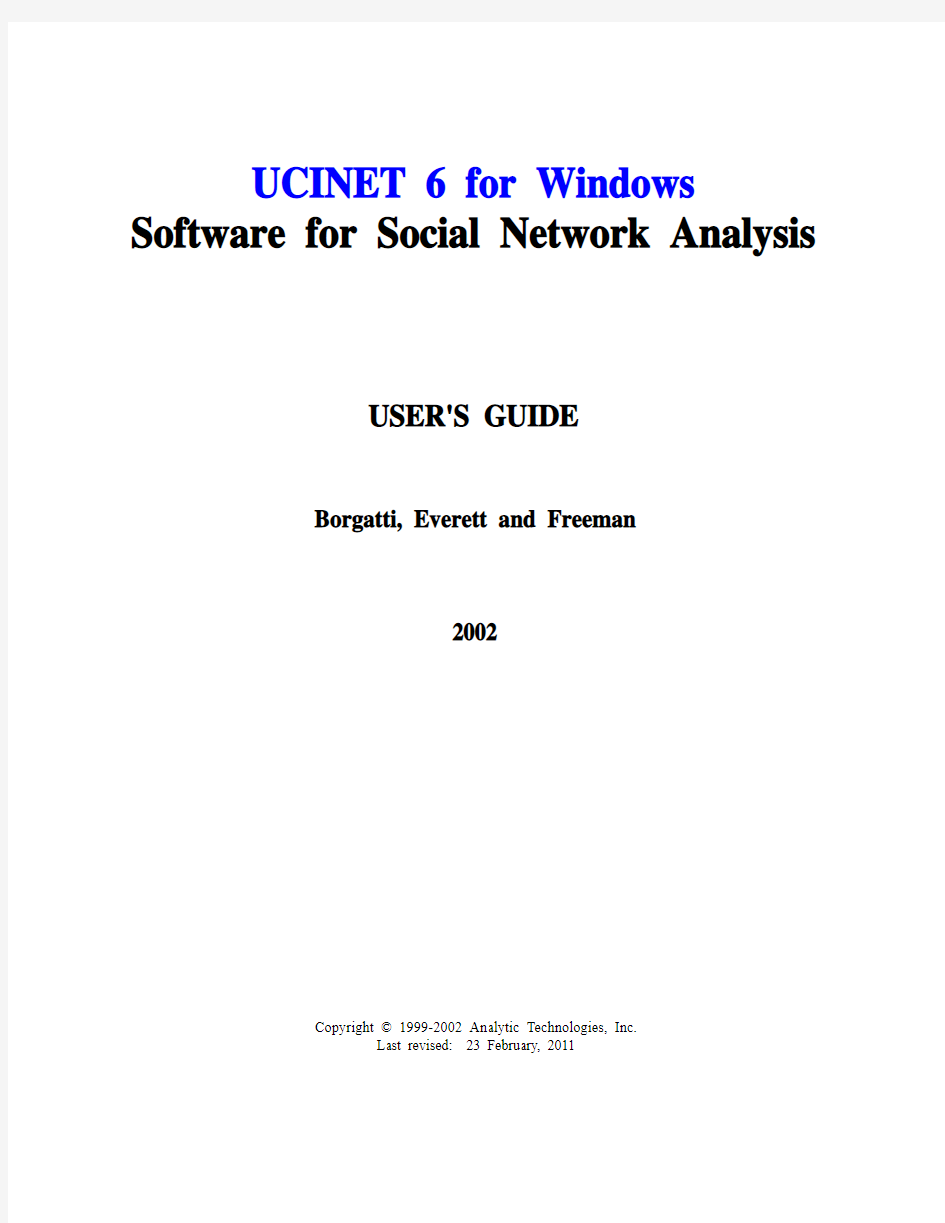
ucinet 6用户手册--适合初学者使用
- 格式:pdf
- 大小:675.18 KB
- 文档页数:49


UCINET 6 for Windows Software for Social Network Analysis
USER'S GUIDE
Borgatti, Everett and Freeman
2002
Copyright © 1999-2002 Analytic Technologies, Inc.
Last revised: 23 February, 2011
UCINET 6
1999-2002 Analytic Technologies. All rights reserved.
Analytic Technologies
11 Ohlin Lane
Harvard, MA 01451 USA
Voice: (978) 456-7372
Fax: (978) 456-7373
Email: support@;sales@
Table of Contents Preface 0 Notational Conventions 0.1 Acknowledgements 0.2 Programming Considerations 0.3 Content 0.4 Matrix Orientation 0.5
Getting Started 1 Hardware 1.1 Installation 1.2 Quitting the Program 1.3 Technical Support 1.4 Citing The Program 1.5 License and Limited Warranty 1.6
The UCINET Environment 2 Menus and Help 2.1 Forms 2.2 Running An Analysis 2.3 The Log File 2.4 Datasets 2.5 Program Organization 2.6 File Submenu 2.7
Data Submenu 2.8
Transform Submenu 2.9
Tools Submenu 2.10
Networks Submenu 2.11
Options Submenu 2.12
Importing Data 3 RAW Filetype 3.1 Excel Filetype 3.2 DL Filetype 3.3 Full Matrix Format 3.4
Rectangular Matrices 3.5
Labels 3.6
Multiple Matrices 3.7
External Data File 3.8
Diagonal Absent 3.9
Lowerhalf and Upperhalf Matrices 3.10
Blockmatrix Format 3.11
Linked List Formats 3.12
Nodelists 3.12.1
Edgelist Formats 3.12.2
Edgearray Format 3.12.3
UCINET Spreadsheet Editor 3.15 Data Processing 4 Subgraphs and Submatrices 4.1 Merging Datasets 4.2 Permutations and Sorts 4.3 Transposing and Reshaping 4.4 Recodes 4.5 Linear Transformations 4.6 Symmetrizing 4.7 Geodesic Distances and Reachability 4.8 Aggregation 4.9 Normalizing and Standardizing 4.10 Mode Changes 4.11 Where is it now? 5
~ 0 ~
Preface 0.1 Notational Conventions
UCINET is menu-driven Windows program. This means you choose what you want to do by selecting items from a menu. Menus may be nested, so that choosing an item from a menu may call up a submenu with additional choices, which in turn may call up submenus of their own. Consequently, to get to certain choices, you may have to select through a number of menus along the way. To represent the options you must take to a given choice, we use angle brackets. For example, to run the hierarchical clustering procedure, you must first start UCINET, then click on the top toolbar and point to Tools, from the drop down menu that appears highlight Cluster and from the submenu that appears click on Hierarchical. We will represent this series of choices as
Tools>Cluster>Hierarchical
0.2 Acknowledgements
Dozens of people have contributed to UCINET 6 for Windows by making suggestions, contributing technical expertise, finding bugs, and providing moral and financial support. We especially thank Charles Kadushin, David Krackhardt, Ron Rice and Lee Sailer for their early and continued support. We also thank those who have contributed technical expertise for specific algorithms, including Pip Pattison (semigroups), Kim Romney (correspondence analysis) and Stan Wasserman (p1).
We are also grateful to Brian Kneller (University of Greenwich, London) for doing much of the initial programming on the Windows interface. The non-metric MDS program is adapted from UCINET 3.0 (MacEvoy and Freeman, 1985), which in turn was drawn from the University of Edinburgh's MINISSA program. Many of the procedures make use of routines found in Numerical Recipes in Pascal by Press, Flannery, Teukolsky and Vetterling, and EISPACK (Smith et. al. 1976, Springer-Verlag).
0.3 Programming Considerations
To paraphrase an old song (and reverse the meaning), UCINET 6.0 is built for speed, not for comfort. Oftentimes during the programming of UCINET, we had to choose between using a fast algorithm that used a lot of memory (and therefore reduced the maximum size of network it could handle), and a slow algorithm that saved memory and could handle much larger datasets. In previous versions we tried to strike a balance between the two. In this version, we usually chose speed. One reason for this is that it is precisely when working with large datasets that speed is essential: what good is an algorithm that can handle thousands of nodes if it takes days to execute? The other reason is that advances in hardware and operating system software continually extend the amount of memory programs can access, so it seems a waste of programming time to work out ways to economize on memory.
One consequence of menu systems is the need to organize program capabilities into categories and subcategories in a way that is logical and comprehensible. Of course, this has proved to be impossible. With only a little effort one can discover several competing schemes for classifying all the functions that UCINET 6.0 offers. None of the schemes is perfect: each does an elegant job of classifying certain items but seems forced and arbitrary with others. The scheme we have settled on is no exception. The basic idea is that under "network" we put techniques whose reason for being is fundamentally network-theoretic: techniques whose interpretation is forced when applied to